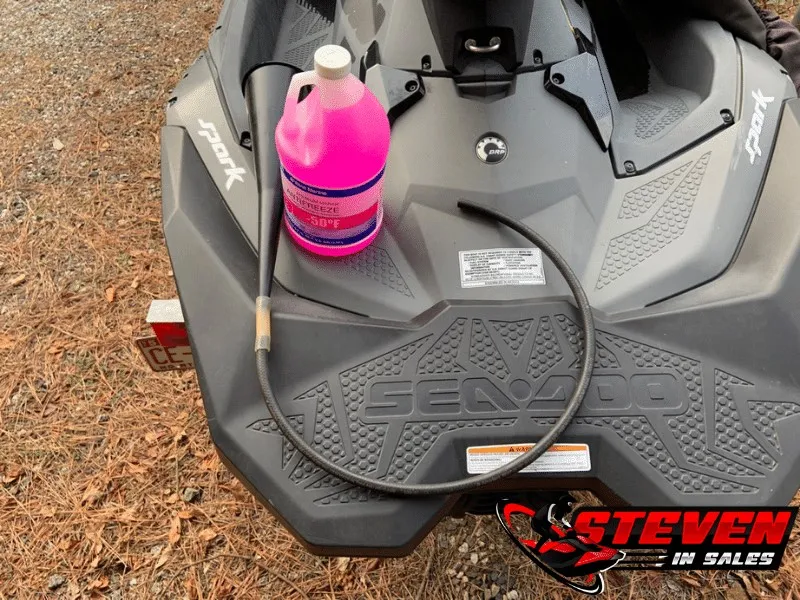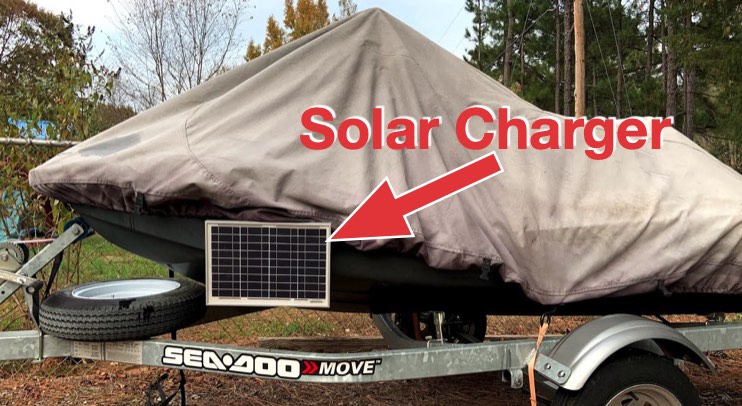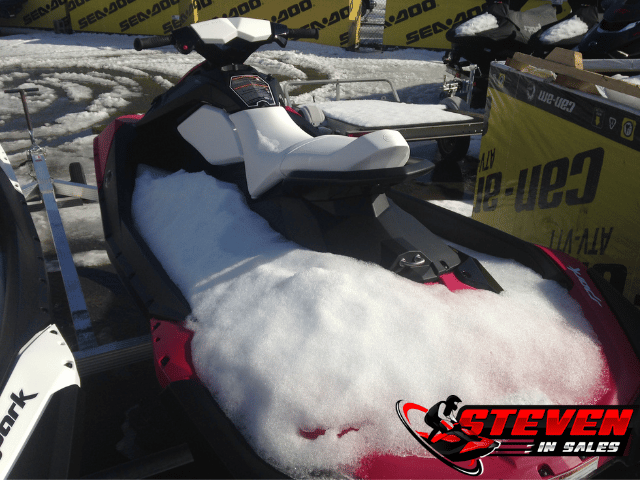As the chill of winter sets in, it’s time to start thinking about safeguarding your jet ski against the biting cold and freezing conditions.
It’s important that you ensure your jet ski is thoroughly prepared for the winter months for maintaining its performance and longevity!!!
In this guide, I’ll take you through the necessary steps and tips to winterize your jet ski. It’s a super important process to do, especially if you live somewhere that gets below 40F/5C, and far too many people forget to do it!
What you Need To Winterize A Jet Ski:
You’ll need to purchase several items for multiple years of use.
- 1-Gal (per machine) of RV/Marine Antifreeze.
- Marine fuel and gas stabilizer.
- Fogging spray storage oil.
- WD-40 Silicone spray lubricant.
It’s good to know that everything, expect 1-Gal of antifreeze, you’ll use multiple years.
Safety Tips!
Just because the process may look simple, it doesn’t mean you ignore some important safety tips. I’ve gathered some critical safety tips for you to consider.
- Protective Gear: Wear gloves and eye protection as indicated by warning labels on supplies.
- Ventilation: Operate within adequately ventilated spaces while employing spray lubricants and chemicals to prevent inhalation of fumes.
- Fire Safety: Practice fire safety precautions with flammable sprays by maintaining distance from open flames or sparks and ensuring sprayed areas are ventilated before engine ignition.
- Battery Safety: Disconnect and place the battery in dry and cool place. Always disconnect the negative cable first. When adding, do positive cable first.
- Antifreeze Handling: Avoid skin and eye contact with antifreeze. Rinse thoroughly with water if contact occurs. Keep antifreeze out of reach of children and pets.
- Slippery: Be cautious of antifreeze spillage.
- Read Labels: Always follow product label instructions and warnings.
- Good Lighting: Work in well-lit conditions for clarity and safety.
- Double-Check: Before winter storage, thoroughly inspect everything, including loose bolts and caps, even in areas you didn’t work on.
How To Winterize Your Jet Ski
It’s good to know that to winterize a jet ski, you must add fuel stabilizer, flush it with antifreeze, fog the cylinders, remove the battery, and lubricate parts.
Below, I’ve listed all the steps you need to take to winterize your jet ski:
1: Add Fuel Stabilizer
You will need to add some fuel stabilizer to the gas tank to keep the fuel in great shape as the jet ski sits. The fuel stabilizer bottles generally include measurements suitable for gas tanks ranging from 5 to 20 gallons.
If you’re wondering about whether to keep the tank full or nearly empty is up to you.
You want to add the fuel stabilizer first so we know it mixes well and gets into all the fuel lines when you start to work on the next steps.
2: Flush With Marine Antifreeze
The most important step when winterizing, involves removing the water from the engine and exhaust system of your jet ski!
The way you remove water from the engine is by using marine-grade antifreeze. Below, I’ve listed the steps to flush the jet ski with the antifreeze.
- Level craft.
- Connect the drill pump with the flush port and get the antifreeze ready.
- Turn the engine on.
- Activate drill pump and utilize the entire gallon of antifreeze.
- When you use up the whole gallon of antifreeze, turn off the drill pump, then switch off the engine.
You want antifreeze coming out the exhaust, nozzle or side discharge port. If you don’t see antifreeze come out of ONE of these ports after 20 seconds, turn the pump off and then the engine off, as something not going to plan!!!
The owner’s manual suggests using compressed air for removing any water, but I prefer marine antifreeze.
I find it easier for people to get a drill pump than to get a sufficiently powerful air compressor.
Should you add water to the antifreeze? The Marine and RV antifreeze should come pre-diluted and ready. Additionally, water remains in the cooling system of your jet ski, hence winterization, as it inevitably blends with water.
3: Coat & Fog Internal Engine Parts
The reason you want to fog the engine is to cover internal metal components to prevent rusting during periods of inactivity.
To fog an engine requires removing all spark plugs and spraying fogging oil into each cylinder for about 3 seconds.
At the start of the season, it’s advisable to replace all spark plugs because of the effect of fogging oil.
4: Remove Battery & Charging Suggestions
The reality is that watercraft batteries go flat during winter storage, so it’s best we remove them and keep them somewhere dry and above freezing temperatures.
Ideally, connect your battery with a smart charger that manages charging automatically. Alternatively, you can charge it every other month.
The types of batteries matter, as sealed/AGM batteries last longer and take abuse better.
Will your battery be dead if it doesn’t get charged over winter? Maybe. The biggest complaint at the start of the seasons I get from people is that their Sea-Doo won’t start, and it’s because of the battery. Sea-Doo batteries are small and don’t get used enough, leading to them die. A battery charger proves effective in maintaining battery freshness throughout the winter season. I, personally, use a solar charger as I keep my Sea-Doo outside and get 5 years out of my batteries.
The solar charger doesn’t need direct sunlight and will keep batteries active and happy! It’s so stupid easy and effective that I don’t know why the manufacturers don’t just give them to people?
5: Spray WD40 specialist Silicone Lubricant
You’ll want to spray WD40 silicone spray lubricant on all metal and electrical parts, including the engine and jet pump area.
Let it sit for 15 minutes so it can air out, it’s flammable!!!
Make sure to lubricate the throttle and steering cables with marine grease.
Avoid regular WD-40, use the silicone version. The regular stuff doesn’t coat, it merely displaces water.
Here’s a useful tip for those residing near saltwater: regularly apply silicone spray on engine and jet pump areas. Repeat this process a few times annually, allowing it to air dry for 15 minutes each time, and your PWC will maintain its appearance for years!
6: Put Cover On
I suggest you take out the front storage accessories so you can prevent mold growth during storage.
Make sure to use a cover, even indoors, for guarding against rodents, spiders, dust, and when outdoors, snow, sun, rain, and more.
Please consider getting shrink wrapping done to your jet ski. Shrinking wrapping keeps the jet ski in perfect condition; snow and rain won’t affect it.
What happens when Water Freezes?
Not many people know this about water, but it works differently than most other things in this world.
The special characteristic of water is its ability to expand when freezing. This expansion poses a challenge for boats, as they draw in water for engine cooling. The force generated by water freezing is powerful enough to fracture metal, such as your engine block.
This process is slow, but powerful, and the damage that frozen water can do is costly!
Trailer Maintenance Care
Regular trailer maintenance is essential for prolonging the lifespan of your trailer.
Here’s what I suggest you to do:
- Lubricate wheel bearings.
- Lubricate latch.
- Ensure correct air pressure in tires.
- Attempt to lift the tires off the ground when sitting for extended periods. Place blocks under the axle. Detach a tire to discourage theft of trailer.
- Inspect straps, substituting any that show wear or fading.
- Apply anti-corrosion spray to trailer.
If keeping a PWC on a trailer, consider tilting the trailer back by placing something under its nose. This action lets any stagnant water flow out from footwells or hull, preventing bugs and animals.
Storing Watercraft?
Keeping your PWC in the water for a few days is fine, but any longer and you need a proper solution. Leaving them in the water for too long can damage it or worse, it can sink.
You have several options for long-term storage:
- Trailer
- Lift
- Marina
The options mentioned above are common. Many trailer owners choose to store their trailers on the trailer itself, which is effective. Although some trailer maintenance, as detailed in this post, is required, this method often proves to be a cost-effective option for many.
For lakefront residents, I recommend investing in lifts made for jet skis. The options include lifts for driving onto or lifts that elevate your watercraft. Try figuring out what’s the perfect lift for your needs, I have a post that covers that here.
An alternative involves docking your jet ski at the marina. The marina handles both launching and retrieving your jet ski, or provides a slip for your convenience.
Either option you go with, I suggest you put a cover on your machine. Or, if you can, keep it in doors or at least covered.
Security Protection
When your PWC will be inactive for an extended period, consider the risk of theft.
It’s important to understand that jet skis are highly sought after by thieves, particularly because they often contain significant amount of fuel and their compact size makes them easy targets for quick thefts.
When you store your jet ski on trailer, using trailer locks becomes vital. Making your jet ski harder to steal discourages potential thieves from targeting your PWC.
While situated on lifts, ensure the security of your PWC by using chains or cable locks to attach the bow hook to the lift or dock.
For more information on security, read my post here.



Hi Steven,
Last week I snagged a 2020 GTI SE with sound system for $10,299 including trailer. 66 hours. With the prices and availability of things right now I didn’t feel too bad about that.
When I go to winterize that, is it better to winterize with a near full tank of gas or do I want to run the gas down as low as possible before tucking it away?
Fuel tank level is more of a personal preference. Many people like to fill it all the way up and then add the fuel stabilizer. I personally keep the gas tank under two bars and then add the fuel stabilizer. Then when the season starts I fill it up with premium and it hasn’t failed me yet.
Thanks… I know Sea-Doo recommends just 87 octane gas. You feel better with premium? How about ethanol free?
If it’s non-supercharged then regular is fine, but if it’s supercharged I would run premium. At the start of the season, I always put in premium to freshen up the gas that’s been sitting during the winter. If you can avoid ethanol do that but it’s no big deal if you can’t.
Steven,
Can you help me? I live in Lake Tahoe and Cave rock boat ramp is open all winter long. My plan is to wear a long wetsuit and ride my Jetski (2021 Sea-Doo GTX230) probably into November. Do I need to winterize it if I am riding it 1-2 times a week in November? After November I will definitely winterize it but just wanted to see if it is safe to ride it regularly into November?
Thank you,
Daniel
If it gets below freezing for more than 24 hours I would at least do the RV & Marine antifreeze flush.